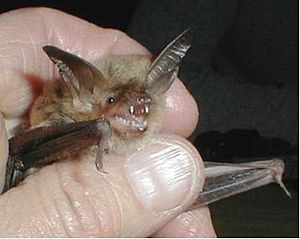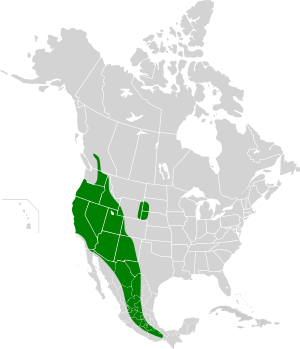Fringed myotis facts for kids
Quick facts for kids Fringed myotis |
|
|---|---|
 |
|
| Conservation status | |
| Scientific classification | |
| Genus: |
Myotis
|
| Species: |
thysanodes
|
 |
|
The fringed myotis (Myotis thysanodes) is a type of bat found in British Columbia, Mexico, and the western United States. It gets its name from a special fringe of hairs on the membrane between its hind legs.
Contents
What is a Fringed Myotis?
The fringed myotis is a small bat with a unique look. It has the shortest ears among bats in its "long-eared myotis" family. The most interesting part is the fringe of short, stiff hairs on the skin between its back legs. This is where it gets its name!
These bats can live for a long time, sometimes more than 18 years. They are about 85 millimeters (about 3.3 inches) long and weigh around 8.8 grams (less than half an ounce). Their ears are about 16.5 millimeters long and stick out a bit past their nose. Female fringed myotis bats are usually bigger than the males.
Their fur is thick and can be light yellow-brown or olive on their back. Their belly is usually off-white. Bats living in northern areas tend to have darker fur.
How Do Fringed Myotis Live?
What Do Fringed Myotis Eat?
The fringed myotis mainly eats beetles, which make up most of its diet. They also eat other flying insects, especially moths, which they hunt later in the evening. Sometimes, they eat spiders and grasshoppers too.
Scientists think the special fringe of hairs on their tail membrane helps them catch insects while flying. These bats are known to hover in the air and even land on the ground to find food. They often hunt for insects over water or in open areas. They can also pick insects off leaves and plants.
Where Do Fringed Myotis Live?
The fringed myotis lives mostly in the western United States. You can find them as far north as British Columbia in Canada and as far south as Mexico.
They prefer to live in desert shrublands, areas with sagebrush and grass, and forests with Douglas-fir, Oak, and Pine trees. They usually live at elevations between 1,200 and 2,100 meters (about 3,900 to 6,900 feet). However, they have been seen as high as 2,850 meters (about 9,350 feet) in New Mexico and as low as 150 meters (about 490 feet) in California.
Fringed Myotis Behavior
Where Do Fringed Myotis Rest?
During the summer, fringed myotis bats use many different places to rest during the day. These include caves, old mines, and even buildings. We don't know much about where they rest in the winter.
Most of the time, they rest in cracks in rocks. But bats living in the Pacific Northwest often rest inside tall, dead trees called "tree snags."
How Do Fringed Myotis Find Things?
Fringed myotis bats use echolocation to find their way around and hunt. This means they send out sounds and listen for the echoes to create a picture of their surroundings. You can often tell a fringed myotis by the specific sound of its echolocation call. It starts with a high-pitched sound that quickly drops to a lower frequency.
When Are Fringed Myotis Active?
The fringed myotis is a nocturnal animal, meaning it is active at night. They usually start flying within five hours after sunset. Their busiest time is usually one to two hours after the sun goes down.
They are not very active when it's raining. Rain makes it hard for them to use echolocation, fly, and keep warm. Rain also means fewer insects are flying around for them to eat. From October to March, these bats hibernate, which means they go into a deep sleep to save energy. They might travel short distances to find a good place to hibernate.
How Do Fringed Myotis Fly?
The fringed myotis has short, wide wings. This design helps them fly at slower speeds but allows them to turn and move very well in the air. They tend to fly close to trees and plants when they are hunting. Their wings are also very strong and can resist punctures. This is helpful for bats that hunt near thorny or thick plants.
Reproduction and Life Cycle
Most fringed myotis bats mate in the autumn. The female bat becomes pregnant between late April and mid-May. The pregnancy usually lasts about 50 to 60 days. This means the young are born in late June to mid-July.
Each mother bat usually has only one baby, called a pup. These pups are very large when they are born! A newborn pup can weigh up to 22% of its mother's weight and be up to 54% of her length.
For the first few weeks, the young bats stay in special "maternity roosts." In these roosts, some female bats stay behind to nurse the babies while other females leave each night to find food. Even though they are not fully developed at birth, the pups can fly just over two weeks after they are born.
See also
 In Spanish: Myotis thysanodes para niños
In Spanish: Myotis thysanodes para niños


